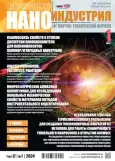Микросферические алмазные наконечники для исследования локальных механических свойств материалов методом инструментального индентирования
- Авторы: Кушнерева А.С.1, Лактионов И.В.1, Усеинов А.С.1, Орлов С.В.2, Статник Е.С.3, Сомов П.А.3
-
Учреждения:
- ФГБНУ ТИСНУМ
- ИСАН
- НИТУ МИСИС
- Выпуск: Том 17, № 1 (2024)
- Страницы: 44-49
- Раздел: Оборудование для наноиндустрии
- URL: https://journals.eco-vector.com/1993-8578/article/view/627418
- DOI: https://doi.org/10.22184/1993-8578.2024.17.1.44.49
- ID: 627418
Цитировать
Полный текст
Аннотация
Цель данного исследования заключается в разработке и демонстрации методики создания сфероконического алмазного индентора с характерным размером наконечника порядка 5 мкм. Производство описываемого наконечника реализуется за счет использования пикосекундного лазера для формирования заготовки и фокусированного ионного пучка для финальной обработки изделия. Для контроля геометрии в процессе изготовления использовался атомно-силовой микроскоп. Высота рабочей области полученного наконечника составила 1 мкм. В исследовании также продемонстрирована применимость изготовленного индентора и приведены диаграммы нагружение-внедрения во время индентирования и АСМ-изображения остаточных отпечатков.
Ключевые слова
Полный текст
Об авторах
А. С. Кушнерева
ФГБНУ ТИСНУМ
Автор, ответственный за переписку.
Email: kushnereva.as@phystech.edu
ORCID iD: 0000-0002-8756-6722
стажер-исследователь
Россия, ТроицкИ. В. Лактионов
ФГБНУ ТИСНУМ
Email: kushnereva.as@phystech.edu
ORCID iD: 0000-0002-8576-3669
стажер-исследователь
Россия, ТроицкА. С. Усеинов
ФГБНУ ТИСНУМ
Email: kushnereva.as@phystech.edu
ORCID iD: 0000-0002-9937-0954
к.ф.-м.н., зам. дир. по науч. раб.
Россия, ТроицкС. В. Орлов
ИСАН
Email: kushnereva.as@phystech.edu
ORCID iD: 0000-0003-2086-284X
вед. инж.
Россия, ТроицкЕ. С. Статник
НИТУ МИСИС
Email: kushnereva.as@phystech.edu
ORCID iD: 0000-0002-1105-9206
мл. науч. сотр.
Россия, МоскваП. А. Сомов
НИТУ МИСИС
Email: kushnereva.as@phystech.edu
ORCID iD: 0009-0003-9398-6410
мл. науч. сотр.
Россия, МоскваСписок литературы
- Meng L. et al. Identification of material properties using indentation test and shape manifold learning approach // Computer Methods in Applied Mechanics and Engineering. 2015. V. 297. PP. 239–257.
- Feng Yu, Jian Fang, Omacht D., Mingcheng Sun, Yingshi Li. A new instrumented spherical indentation test methodology to determine // Theoretical and Applied Fracture Mechanics. 2022. V. 124, no. 4. P. 1037.
- Han T. et al. Free standing nanoindentation of penta-graphene via molecular dynamics: Mechanics and deformation mechanisms // Mechanics of Materials. 2023. V. 180. P. 104628.
- Farmakovskaya A.A., Okorokova N.S., Perchenok A.V. Application of the spherical indenter for determination of the elastic modulus of coatings // E3S Web of Conferences. EDP Sciences, 2023. Т. 389. P. 01084.
- Marimuthu K.P. et al. Spherical indentation for brittle fracture toughness evaluation by considering kinked-cone-crack // Journal of the European Ceramic Society. 2017. V. 37, no. 1. PP. 381–391.
- Hill R., Storåkers B., Zdunek A.B. A theoretical study of the Brinell hardness test // Proceedings of the Royal Society of London. A. Mathematical and Physical Sciences. 1989. V. 423, no. 1865. PP. 301–330.
- Mesarovic S.D., Fleck N.A. Spherical indentation of elastic–plastic solids // Proceedings of the Royal Society of London. Series A: Mathematical, Physical and Engineering Sciences. 1999. V. 455, no. 1987. PP. 2707–2728.
- Huang C.C., Chiang T.C., Fang T.H. Grain size effect on indentation of nanocrystalline copper // Applied Surface Science. 2015. V. 353. PP. 494–498.
- Broitman E. Indentation hardness measurements at macro-, micro-, and nanoscale: a critical overview // Tribology Letters. 2017. V. 65, no. 1. P. 23.
- Qian L. et al. Comparison of nano-indentation hardness to microhardness // Surf. Coatings Technol. 2005. V. 195, no. 2–3. PP. 264–271.
- Wu M. et al. The influence of the focus position on laser machining and laser micro-structuring monocrystalline diamond surface // Optics and Lasers in Engineering. 2018. V. 105. PP. 60–67.
- Parandoush P., Hossain A. A review of modeling and simulation of laser beam machining // International journal of machine tools and manufacture. 2014. V. 85. PP. 135–145.
- Lin Z., Ji L., Wang W. Precision machining of single crystal diamond cutting tool via picosecond laser irradiation // International Journal of Refractory Metals and Hard Materials. 2023. V. 114. P. 106226.
- Coq Germanicus R. et al. Quantitative mapping of high modulus materials at the nanoscale: comparative study between atomic force microscopy and nanoindentation // Journal of Microscopy. 2020. V. 280. no. 1. PP. 51–62.
- Roa S., Haberkorn N., Sirena M. Atomic force microscopy nano-indentation for testing mechanical properties in thin films // Materials Today: Proceedings. 2019. V. 14. PP. 113–116.
- Haggag F.M. Standard Test Methods for Automated Ball Indentation (ABI) Testing of Metallic Materials and Structures to Determine Tensile Properties and Stress-Strain Curves // Advanced Technology Corporation. 1988–2009. PP. 2–20.
- ГОСТ Р 56232-2014. Определение диаграммы "напряжение – деформация" методом инструментального индентирования шара. Стандартинформ, 2016. P. 2–32.
- Chao Chang, Garrido M.A., Ruiz-Hervias J., Zhu Zhang, Le-le Zhang. Representative Stress-Strain Curve by Spherical Indentation on Elastic-Plastic Materials // Advances in Material Science and Enginiring. 2018. V. 2018. P. 9.
- Kucharski S., Woźniacka S. Size effect in single crystal copper examined with spherical indenters // Metallurgical and Materials Transactions A. 2019. V. 50. PP. 2139–2154.
- Pathak S. et al. Understanding pop-ins in spherical nanoindentation // Applied Physics Letters. 2014. V. 105, no. 16.
Дополнительные файлы











